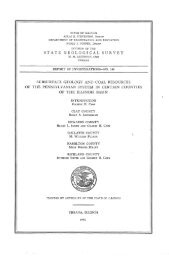Cores 11 through 26 by Gary B. Dr - University of Illinois at Urbana ...
Cores 11 through 26 by Gary B. Dr - University of Illinois at Urbana ...
Cores 11 through 26 by Gary B. Dr - University of Illinois at Urbana ...
You also want an ePaper? Increase the reach of your titles
YUMPU automatically turns print PDFs into web optimized ePapers that Google loves.
in Figure 5 indic<strong>at</strong>e the approxim<strong>at</strong>e loc<strong>at</strong>ions <strong>of</strong> the sampling sites. The core number, the county in whichthe core was collected, and the length <strong>of</strong> the core are recorded in Table 1.A Giddings® hydraulically oper<strong>at</strong>ed coring device mounted on a two-ton pickup truck was used to collectall cores. A combin<strong>at</strong>ion <strong>of</strong> unsplit and split core barrels was used, depending on conditions encounteredin the soil. The core barrel was pushed into the soil/sediment with no applied rot<strong>at</strong>ion. The cores werebriefly described in the field as they were collected. Each core segment, approxim<strong>at</strong>ely two feet long, waswrapped in plastic food wrap, then overwrapped with heavy-duty aluminum foil. The cores were labeledand placed in core boxes for transport and storage.LABORATORY METHODSAt the ISGS the cores were unwrapped, trimmed to remove any smeared and/or oxidized m<strong>at</strong>erial fromthe outer surface, and described in more detail than was possible in the field. Samples were selectedfrom the cores for chemical analysis on the basis <strong>of</strong> observable lithologic changes. Samples were dried <strong>at</strong>50C. The dried samples were then disaggreg<strong>at</strong>ed to approxim<strong>at</strong>ely
















